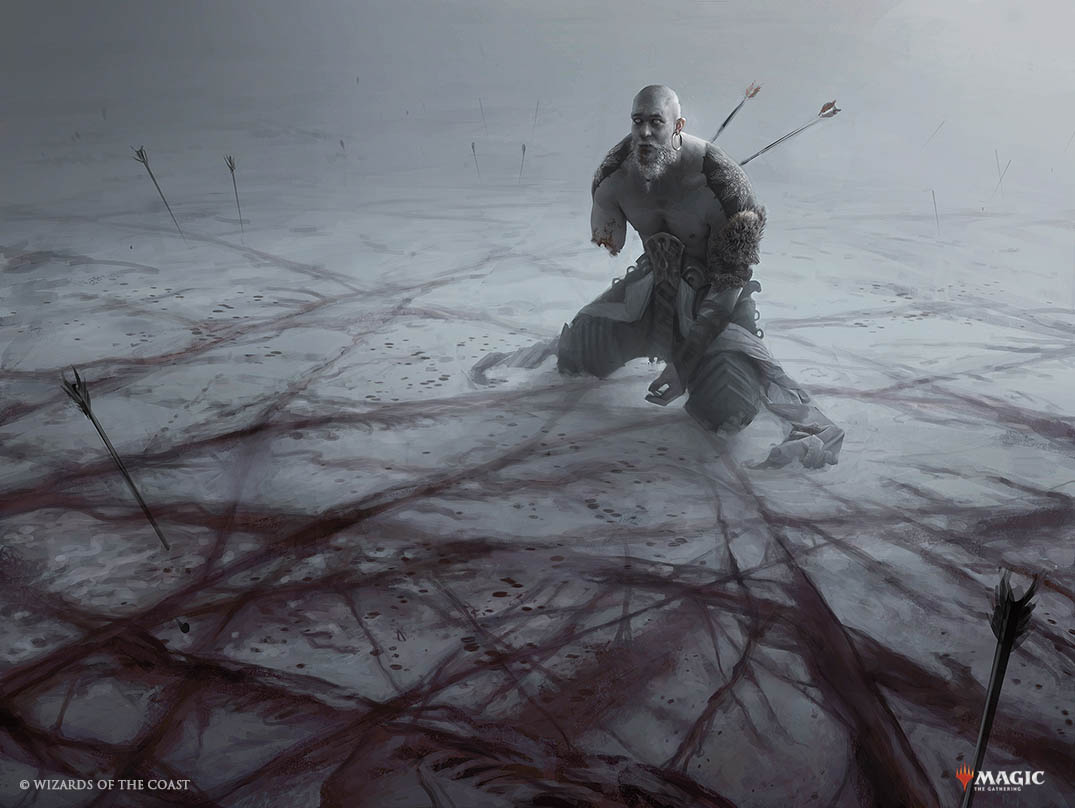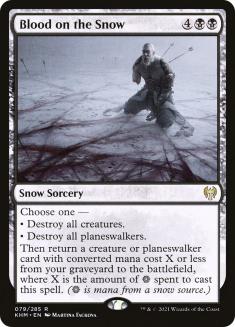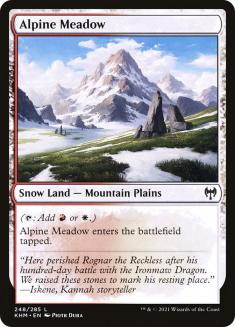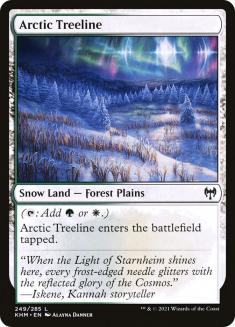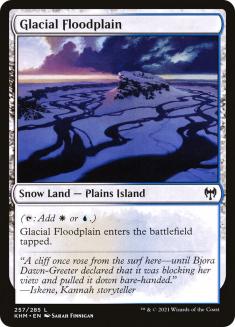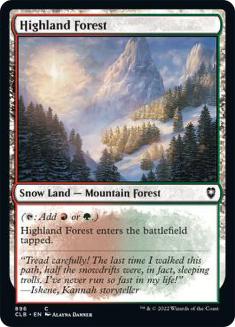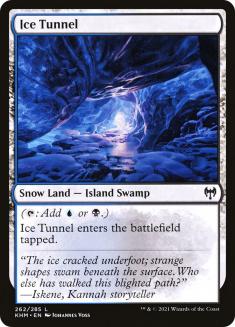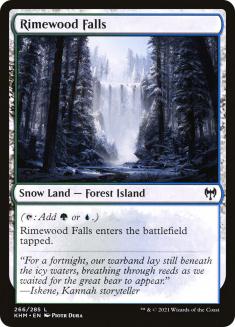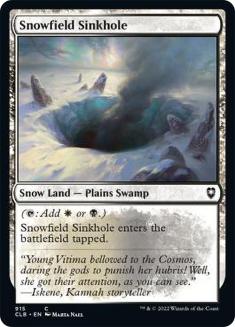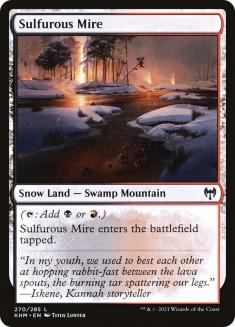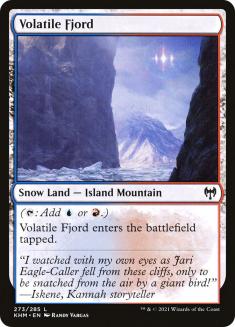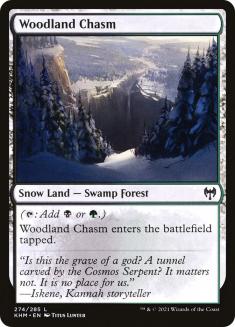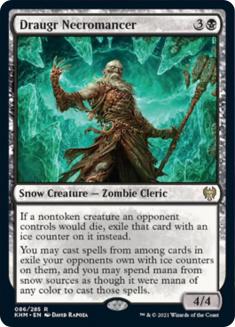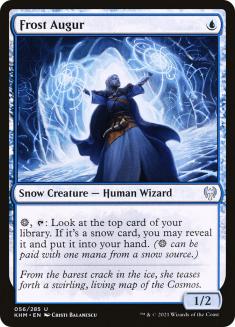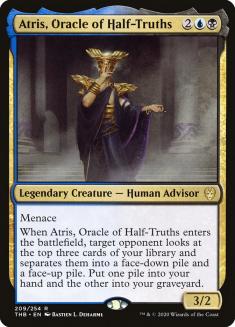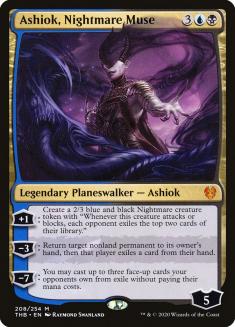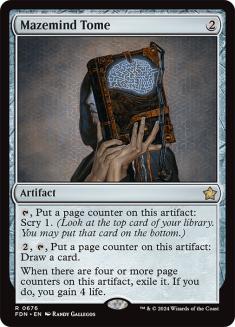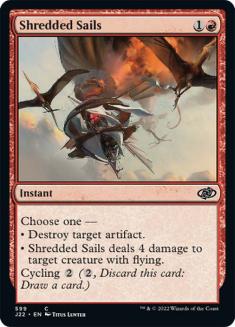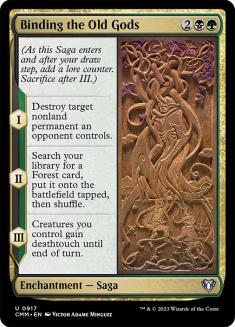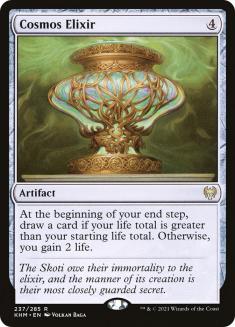Blood on the Snow feels like one of those cards that kinda slipped through the cracks of preview season.
It got confirmed pretty late in the process, and beyond that, Blood on the Snow asks a lot from you in deckbuilding. That said, the juice looks to be worth the squeeze. Blood on the Snow is a powerful and unique sweeper that has the potential to turbo-charge a variety of macro-archetypes.
For starters though, six mana is a lot. There’s a natural limit to how many cards you can play that cost six or more mana without dedicated ramping. It also asks you to play a bunch of snow mana, which naturally runs up against Triomes and three-color manabases. On the flip side, there is a full cycle of tapped snow two-color lands in Kaldheim.
Finally, while it sounds simplistic, Blood on the Snow requires you to play creatures or planeswalkers. The key here, unlike a traditional sweeper, is that you actually want to play on the battlefield with Blood on the Snow. The more you can incentivize your opponent to over-extend, the better the resulting sweeper will be when it refunds you cardboard and puts you up in front. Naturally, there are a variety of ways to break the “parity” of being up one card with various enters-the-battlefield creatures or brute-force hammers.
Paired with this is the natural tension of wanting to play an adequate manabase. Blood on the Snow starts to acquire a fail rate as soon as you put even the first Pathway land into your deck. Suddenly if you’re fully reliant on returning the “max value” of five- or six-drops, your deck can start to become less reliable and less functional.
In many ways this points you more towards the midrange end of the spectrum, even if you are interested in controlling the game.
Putting all of these pieces together, there’s a lot of incentive to play strong four-mana creatures (there aren’t really any currently available planeswalkers) that demand an answer — they’re operating with a low fail rate — it’s unlikely for three of your six available lands on the Blood turn to not be snow, and given the right threat the game will naturally slow down or speed up (both acceptable outcomes to cruise into a six-mana sweeper).
Thankfully, there’s a threat in Kaldheim that naturally meets these parameters and it’s going to be our star of the show today.
Draugr Necromancer is basically perfect for Blood on the Snow. It’s a sizable four-mana body that cheaper creatures can’t just naturally attack into; if you untap with it, it threatens to immediately take over any game that’s about the battlefield; and it has excellent synergy with Blood on the Snow directly. If you sweep an opponent’s squad with this on the battlefield, they’ll all be iced and ready to go the following turn as you return your Necromancer.
This sequence and the pressure it places to take over a game is like a hybridization of Kalitas, Traitor of Ghet and The Scarab God. The cherry on top, of course, is that we are already interested in putting snow lands in our deck.
Let’s Start Looking at Some Decklists.
Creatures (11)
Planeswalkers (2)
Lands (26)
Spells (21)

This version of Blood on the Snow is digging deep into Kaldheim’s tools.
While this is a fairly controlling deck on the surface — sweepers, a healthy amount of spot removal, countermagic, full boat of Shark Typhoon — this version of Dimir Control ❄ can put a lot of pressure on its opponents. As I’ve already hyped up, Draugr Necromancer can put games away quickly both with its body and its ability, but Frost Augur is another component that can change the axis upon which the game is played.
Without even breaking the bank, we’ve got 32 snow cards in our deck. Combined with our sideboard plan of Ascendant Spirit, these one-drops can produce a lot of competing pressures from control decks to answer them.
The downside of course is that you now have a Stompable creature in your control deck, so we will have to see how the metagame fully develops, but such a cheap card advantage engine to maximize your odd mana usage is a huge boon to a deck that needs to hit many land drops.
Atris, Oracle of Half-Truths and Ashiok, Nightmare Muse are your supplementary threats.
Atris is about as perfect as can be for this strategy, and in a world that settles with fewer creatures, it could easily swap numbers with the Necromancer. It’s a phenomenal bridge card that can work you towards six mana, while also just being a massive inconvenience to attack through given the often two cards it generates.
Ashiok has quietly seen success but has never really had a place to shine despite showing up from time to time, and Blood on the Snow is another excellent place to include one of the strongest planeswalkers in Standard.
The exact configuration of this strategy will rely on how the metagame shapes of course, but the advantage of this shift towards being more midrange with a sweeper that supports it is apparent as Dimir Control ❄ can operate as either the midrange or control deck depending on the matchup. The ability to play on the battlefield in addition to being able to control the game can’t be underestimated.
A final note — The Trickster-God’s Heist is the most experimental card in the decklist but I suspect it could be a huge sleeper hit in aggressive matchups. It would be difficult for decks like Gruul Adventures to maximize your Frost Augurs, Priest of the Haunted Edges, or Atrises (even with their likely natural swap to snow basics), and most importantly their aces in the hole, Embercleave and The Great Henge, can be swapped out with the Saga.
In practice, it might not come to fruition, but I’m excited to try it and the deck as a whole.
Let’s explore a pure midrange expression of Blood on the Snow:
Creatures (15)
- 4 Bonecrusher Giant
- 2 Ox of Agonas
- 4 Kroxa, Titan of Death's Hunger
- 2 Valki, God of Lies
- 3 Draugr Necromancer
Lands (23)
Spells (22)

By now you’ve likely seen many, many expressions of Rakdos Midrange decks during preview season. Most are heavily graveyard-based and are leaning on Tymaret Calls the Dead and Mire Triton to charge up their synergies. These decks are powerful, and are getting their own fair share of tools from Kaldheim with Valki, God of Lies; Goldspan Dragon; and Immersturm Predator depending on how far along they are on particular axes.
Leaning into snow means your deck will be slower, and frankly less synergistic. However, Draugr Necromancer and Blood on the Snow are huge power adds that once again offer you similar flexibility to the graveyard-based deck to shift roles depending on the matchup. Further, the Necromancer itself represents a huge advantage in any kind of mirror match as it dismantles an opponent’s graveyard synergies as well as naturally takes over the game.
This deck has a smaller density of snow mana than Dimir Control ❄, sporting four copies of the powerful Shatterskull Smashing. However, while four snow mana with Blood on the Snow was the critical breakpoint (with really a desire to have five for Ashiok), here we can get away with returning Bonecrusher Giant, Valki, or even just Kroxa for a clean additional card on top of the sweeper.
Mazemind Tome is the glue that bridges together this deck, helping to insure that Rakdos doesn’t befall the common midrange problem of “drawing the wrong part of my deck,” and helps to put pressure on your opponent to play more aggressively than normal, which plays right into our hands.
Shredded Sails isn’t sexy, but I strongly suspect that decks will still need answers to The Great Henge and Embercleave come Kaldheim’s release.
While worse at downright controlling the game, Rakdos has a stronger collection of raw threats than Dimir and is naturally better at battling through swarms of small creatures with Bonecrusher Giant. Both directions have a lot of merit — coming down to not only personal preference but, again, the natural shifts in the metagame in the early weeks. Given that Gruul Adventures will likely still be one of the most popular decks as folks get adjusted, I’d start here if you’re on the fence.
Finally, I do want to show off a version of Blood on the Snow that leans into ramping. I don’t think it’s as well-tuned as the aforementioned decks, but I think it’s a viable direction for the archetype that’s worth talking about.
Creatures (11)
Planeswalkers (5)
Lands (23)
Spells (21)
- 2 Cultivate
- 4 Wolfwillow Haven
- 2 Extinction Event
- 2 Heartless Act
- 3 Mazemind Tome
- 2 Bloodchief's Thirst
- 2 Binding the Old Gods
- 4 Blood on the Snow
Sideboard

The impetus for building a deck like this is really Solemn Simulacrum. Solemn is an excellent and natural fit for Blood on the Snow, ramping you into it and synergizing with every aspect of the card, but if you don’t have anything to do with the excess mana, it won’t yield as much of an impact as a card like Draugr Necromancer over a large spread of matchups.
So, we’ve got stuff to do with the mana. Garruk and Ugin are both extremely powerful cards and huge game-breakers to bring back with Blood on the Snow. This deck’s threat density is through the roof with our sweeper pulling double duty. Of course, our curve is very high, and our deck is plain slow and potentially awkward if we don’t draw the right mix of cards.
Ramp is another type of strategy that is difficult to maximize on Day 1, but ignoring its potential would be foolish. Furthermore, Binding the Old Gods is an impressive piece of interaction for these types of strategies, covering you from a variety of permanents as well as getting you up cardboard and getting you closer to Ugin. It isn’t exactly incredible at ramping you into your sixes, but it does ensure that you get the critical mass of resources you need to function. Frankly, I might be underrating it with only two copies and it might be one of the biggest draws to this type of deck.
I do want to briefly make some call-outs to Golgari’s sideboard. Cosmos Elixir was a card I considered for both Dimir and Rakdos but ultimately cut, but this is another Mazemind Tome-like card that can dramatically change the axes of matchups.
Battle Mammoth is another card that can put a lot of pressure on opponents and helps your curve to function even if your draw is a bit awkward. It doesn’t have the same “untap-win” punch as Elder Gargaroth, but it’s the type of card that’s going to perform better after sideboard when folks have stronger interaction and games will go longer. Guaranteeing a card on top of a must-answer threat is a big deal.
Enjoy the release of Kaldheim because Standard is about to be shaken up!

